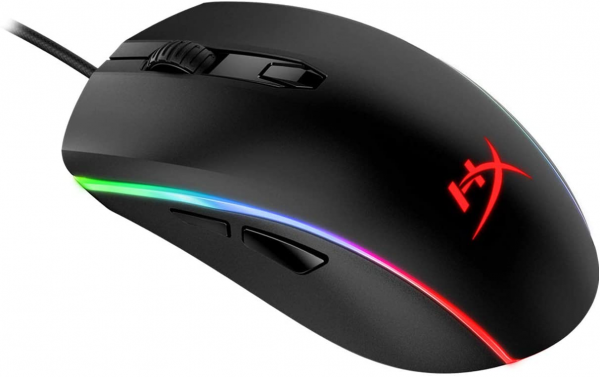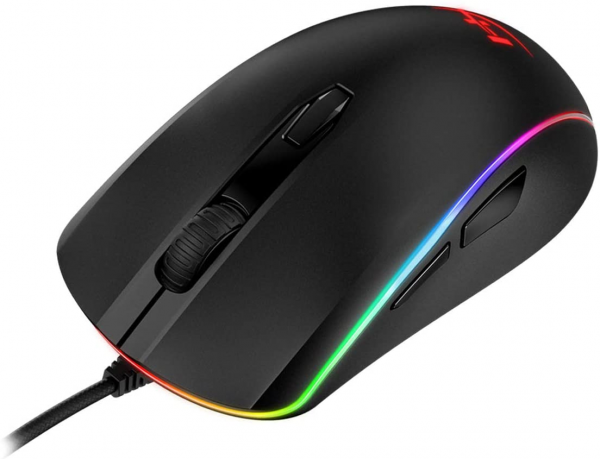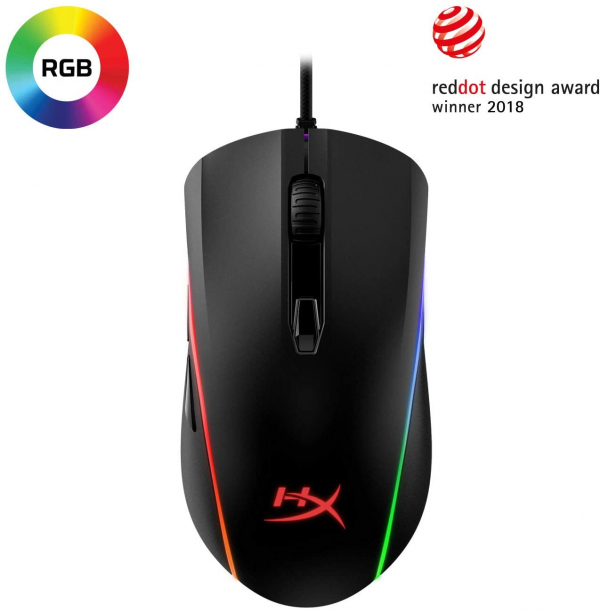HyperX
HyperX Pulsefire Surge: a powerful RGB mouse
Aprox. 54€ - see price -
See specificationsThe Pulsefire series of gamer mice from the manufacturer HyperX is enriched with a new, higher-end version, the Pulsefire Surge. With its ambidextrous design and its advanced optical sensor, it could well attract many players looking for a lively and efficient model.
Positive points
Comfortable grip, non-slip material on the edges.
High performance optical sensor.
Three integrated profiles.
Neat backlight.
Bad points
No buttons on the right edge (for left-handers).
A bit heavy compared to other mice of the same size.
Performance settings limited to the choice of sensitivity levels.
Sensor standby too fast and annoying in office automation.
Our review
Ergonomics
The Pulsefire Surge falls into the category of "almost ambidextrous" mice. Ambidextrous, due to its perfectly symmetrical shape, "almost", because of its additional buttons only placed on the left edge. Like the Logitech G203 and G305, The G-Lab Kult Promethium, Tt eSports Black V2 or Dream Machines DM1 Pro S, this design ultimately reserves the Pulsefire Surge for right-handed audiences.
Lefties wishing to take advantage of buttons on the right edge will prefer real ambidextrous such as the Logitech G900, the SteelSeries Sensei 310, the Razer Lancehead and Lancehead Tournament, the Cooler Master MasterMouse Pro L, the Roccat Kova ...
Apart from this divisive constraint, it must be recognized that the design of the Pulsefire Surge turns out to be rather well studied. Despite a fairly simple shape, it is pleasant to take in hand thanks to well thought out curves: slightly concave main buttons, curved edges making it easier to hold; for a symmetrically shaped mouse, it's a nice surprise. The quality of the materials is not to be outdone, with a matt and pleasant coating under the fingers for the shell and an elastomer layer on the plastic of the slices, promoting adhesion.
Combined with the rather reasonable mass of the mouse (about 104 g on the scale, cable placed outside the tray), we obtain a mouse easy to lift and therefore rather well suited to the game in low sensitivity, where sudden movements and repositioning on the carpet are legion. However, we are a bit hungry, since the mice of this size (120.2 x 62.9 x 40.7 mm) now manage to go under the 100 g mark and are therefore even more manageable. The glide remains happily satisfactory thanks to the large PTFE pads.
In terms of grip, the HyperX Pulsefire Surge is especially designed to be held with the fingertips or with just the base of the palm rested. A more relaxed position is nevertheless possible during calm activities, in office automation for example.
Resolutely simple in its form, the Pulsefire Surge does not forget to flatter the retina with an RGB backlight illuminating the translucent border around the hull as well as the logo located on the top. The proposed effects are few, but fluid and very bright. They can also be deactivated.
HyperX has chosen Omron switches for the main buttons of its Pulsefire Surge. A good choice which translates into free clicks and a guarantee of 50 million activations which should in principle ensure several years of frantic pressure. The edge buttons are a little more flexible, but remain sufficiently responsive. A third additional button finds its place above the wheel and is used to modify the sensitivity of the sensor on the fly (up to 5 levels configurable in the mouse software). Finally, the wheel itself is quite classic; flexible, but well notched, it is clickable, but is not associated with side buttons.

Precision
The Pulsefire Surge takes advantage of PixArt's latest optical sensor, the PMW3389. Even more advanced than the PMW3360 which equips a large number of gaming mice, it supports accelerations up to 50g and speeds up to 10.16 m / s! Insofar as the PMW3360 already displays very high performance and is not faulty despite figures a little less flattering, it is not surprising to find that this new sensor convinces us just as much. After the race for the highest sensitivity would now come the race for speed and acceleration? We will not complain about it, since who can do the most can do the least, but we would prefer to take advantage of more useful improvements, such as a reduction in the minimum height of stall of the sensor in the event of an uplift or even better surface recognition. Indeed, optical sensor requires, glass or other transparent or reflective surfaces should be avoided. In all cases, it is better to favor the use of a mouse pad to get the best out of your mouse, especially for playing.
In terms of sensitivity, the PMW3389 climbs to 16,000 dpi, compared to 12,000 dpi for the PMW3360. Again, this is just a battle of big numbers, since already at 12,000 dpi, a movement of less than a centimeter is enough to cover the entire width of an Ultra HD screen (3,840 x 2,160 px). In short, useless as it stands, but that does not detract from the qualities of such a sensor.
In practice, the agility of the Pulsefire Surge combined with the precision of its sensor makes it suitable for the fastest games and gives it good versatility. We appreciated it as well in FPS as in titles a little more posed, strategy or management, for example.
Small negative point, however, during our tests, the mouse seemed to go to sleep after ten seconds of inactivity, which resulted in a frozen pointer for about a second during recovery. A very painful behavior in office automation when you take back your mouse after typing text on the keyboard. No settings about a possible automatic standby being available in the mouse software, we were not able to get rid of this problem.

Conclusion
Handy and precise, the Pulsefire Surge is intended for all hands and is suitable for many styles of play. Too bad it is not entirely ambidextrous, but right-handers looking for a small efficient mouse will be in heaven.

Specifications
Reviews


Mouse is great. Not sure why other review is upset
Mouse is great. Not sure why other review is upset, you bought a mouse shaped for a palm grip and expected something else? Fps is immaculate. Helped my aim on overwatch a lot. The dpi settings grip and smooothness.
Awesome!
Good mouse, inexcusably horrible software
First, the good ..
The mouse is nice. It has a good feel, a nice weight and it's very responsive both in Wired and Wireless mode. The LED's are nice, they aren't obnoxious and they have a perfect level of brightness that accents the mouse without being ugly. It seems to be well constructed, it feels solid under your hand and it's a very comfortable mouse.
Now the bad ..
Yet another company that just can't handle the simple concept of Mouse Software. This one however, is the worst I have seen yet. The NGenuity Software is not a stand alone installer, it's a Windows Store App. It doesn't run in your tray, it has to stay open in your task bar or you can't have any custom settings for the mouse. If you don't want to have an application open in your tray all the time, you have no customization .. at all. This is inexcusable.
If you turn the mouse off, the horrible software loses all settings. When you turn it back on, you then have to go into the software and select the profile again .. every time. If you plug the mouse in to charge .. now it sees as it as a different mouse and you need a whole new set of profiles. It baffles the mind how horrible this software is.
The mouse is good, but I'll likely return it because this software is just unacceptable. Maybe it will be refined later (It's currently listed as beta version) but right now it's borderline unusable. Avoid this until they release some actual working software unless you're happy with just using the default settings (800/2000/3200 with RGB Breathing effect.)
Could certainly do worse, especially on sale.
Bought this mouse because I wanted to try a larger one than the ones I had (a Nixeus Revel and a Corsair Harpoon RGB), and it was at a pretty good discount at the time of purchase ($ 35, normally retails for ~ $ 50). I've used it for about two weeks, so I feel like I can give a fair assessment about what I like / dislike so far.
LIKES:
* Solid construction, actually feels like it can take a beating
* Plug and play, no fancy drivers needed
* Not too flashy, doesn't have unnecessary RGB all over it
* Mostly well-designed (more on that in a second)
* Braided cable doesn't snag like some of my other mice
DISLIKES:
* Sides are at an odd angle (they're angled in towards the top, whereas most mice angle in towards the bottom)
* Rubberized grips don't grip, especially if your hands get sweaty at all
* Scroll wheel developed an annoying squeak less than a week after I got it
Overall, while I do have some gripes about the shape of the mouse, it's still not a terrible choice, especially if you have larger hands like I do. It's still fairly comfortable in a palm grip, but you may have to hold on somewhat tightly so that it doesn't slide out of your hand. I think it's still decent bang for your buck, especially if you can snag it on sale like I did, and don't mind the palm-grip-only sculpting.
Updated 12/5/19. Feels good, looks good and handles well so far.
Disclaimer: I've only had ~ 2 days with this mouse so far. I mostly play WoW but play other games on the side such as BO4 / CS.
Edit: 12/5/19. Everything I said below has remained completely true for the entire year + that I've had this mouse. It feels really good, it's very durable and it looks really nice. No tracking issues, no left / right click issues that plague other mice, no durability issues, etc. It's worked extremely well for me since I bought it. Very happy overall.
Review:
1. Feel: This mouse feels extremely nice. The grips on the side are made of a very grippable and seemingly durable material. I was able to lift up the mouse so easily I didn't even notice when I was doing it most of the time as it should be. The ergonomics are great as well, fit perfectly in my hand. Hand size is 6.70 inches. The sensor works perfectly as expected from one of the best on the market. It's really smooth. The mouse is fairly light in my opinion and glides across the mouse pad nicely.
2. Look: The mouse looks and feels like a professional mouse (if that's what you wanna call it). The LEDs are very bright and have 3 different patterns (Cycles through colors aka breathing, 1 color mode or no lights). Mouse wheel and logo are very well lit.
3. Durability: As I've said I've only had it for 2 days so I can only comment on what I've felt / seen so far. All of the material looks and feels very durable. I'm hoping this stays true.
4. Software: It's simple and easy to use. That's all there really is to say. If you wanna get more in depth you can watch some guides but overall it's easy to navigate and not riddled with bugs (so far) like Synapse.
TLDR: Feels good, looks good and handles well. Feels well built and durable. Only had it for 2 days and will update the review later down the line but so far so good. Can't find anything negative to say about it so far but I'm also not a super picky person.